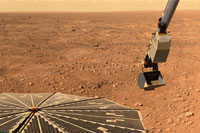Life on Mars To Be Found in 2018
In 1877, during the great opposition of Mars, astronomers discovered the system of so-called canals on the surface of the red planet. Percival Lowell, a well-known astronomer, set out a version of their artificial origin in his book. The mystery of life on Mars has become one of the most talked-about subjects in the field of space exploration since then.

“The War of the Worlds” written by Herbert Wells in 1898 became the first book about the invasion of extraterrestrial creatures. The creatures came to Earth from Mars, of course, and perceived humans as food. The image of a Martian being became more romantic in 1923 after the publication of Aleksei Tolstoy’s Aelita novel. The book tells of the flight of a Soviet spaceship to Mars. The crew of the spaceship found a highly-developed civilization on the planet, which was declining in the grip of bourgeois reality. The image of the main character of the novel, Aelita, deprived many Soviet schoolchildren of sleep despite social and political absurdity of the book.
Other prominent science fiction writers, such as Ray Bradbury and Kurt Vonnegut, did not leave the Martian issue out of their attention either.
However, it seems that the fairytales about scary Martian creatures will soon become history. ExoMars, a European unmanned scientific mission will begin in 2018 to search for signs of life on the mysterious red planet. The launch of the interplanetary space probe was originally planned for 2011, but was later pushed back to 2018 because of the economic crisis.
NASA cooperates with the European Space Agency in the program. The research station with ExoMars rover will be launched on board the US Atlas booster rocket.
ExoMars will deploy a rover carrying a comprehensive suite of analytical instruments dedicated to exobiology and geology research. Using conventional solar arrays to generate electricity, the rover will be able to travel a few kilometres over the surface of Mars. The vehicle will be capable of operating autonomously by using onboard software and will navigate by using optical sensors. Included in its payload will be a lightweight drilling system, a sampling and handling device, and a set of scientific instruments to search for signs of past or present life on Mars.
The rover will weigh 205 kg, comparable to NASA's Mars Exploration Rovers Spirit and Opportunity. Instrumentation will consist of the 10 kg 'Pasteur Payload' and the 'Geophysical Science Package', containing, among other instruments, a 2 meter sub-surface drill.
The ExoMars spacecraft will consist of an orbiter, the carrier module, a high-precision Entry, Descent, and Landing (EDL) system, and the rover itself with the main scientific payload. The 2018 launch opportunity is actually one of the most favorable in terms of planetary alignment for many years, and that makes it possible to send a very heavy surface mission. After 9 to 10 months of flight, the orbiter with the Carrier and Descent Modules attached will enter Martian orbit. The landing from an orbiter makes it possible to wait for a storm free period and to land with a higher accuracy.
Subscribe to Pravda.Ru Telegram channel, Facebook, RSS!


